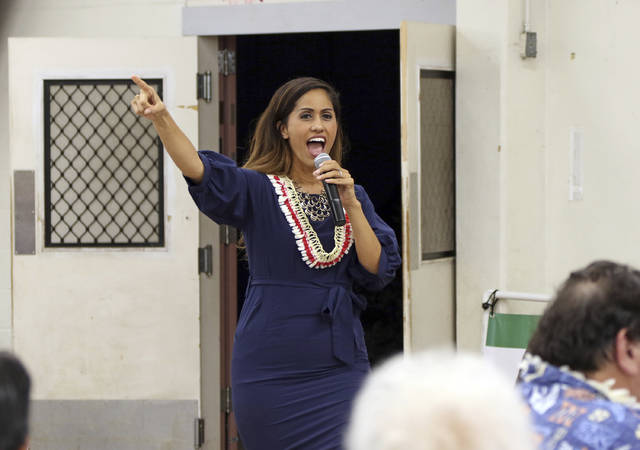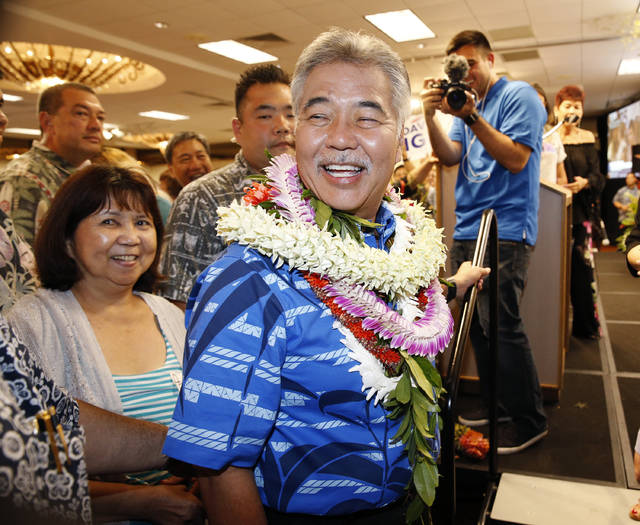Crushing housing costs hit Hawaii’s race for governor


HONOLULU — Candidates for Hawaii’s top elected office are focusing on a persistent problem that has only gotten worse: the high cost of housing on the islands.
Andria Tupola, the Republican candidate for governor, said her party’s internal polling shows cost of living is the greatest concern for 55 to 60 percent of voters. She said she’s spoken to people who are leaving because they can’t afford to stay in the state.
She recalled one small-business owner in the Honolulu suburb of Hawaii Kai saying he supported her but this would be his last election in Hawaii.
“He said ‘I’m just tired. We’re tired of the struggle. Every day we work super hard and we’re barely making it,’” she said.
A recent report by the National Low Income Housing Coalition said a full-time worker in Hawaii must earn $36.13 an hour to afford a two-bedroom apartment at fair market rent of $1,879.
That hourly wage amounts to $75,158 a year. According to the U.S. Bureau of Labor Statistics, average annual wages in Hawaii totaled $48,178 in 2016, 10.2 percent less than the U.S. average.
A worker earning Hawaii’s minimum wage of $10.10 per hour would need to work 3.6 full-time jobs to afford the same apartment.
The median price of a single-family home on Oahu, the state’s most populous island, hit $812,000 in September. That’s more than double the national median.
Gov. David Ige, who is running for re-election, said he hears similar concerns about housing and homelessness. Hawaii has the nation’s highest homeless population per capita.
The two candidates face off in Tuesday’s midterm election.
Tupola, 37, said she would like Hawaii residents to have priority in buying land, so they aren’t priced out. She wants to decrease the length of time needed for builders to get permits. She wants the state to partner with more local developers.
“There’s two ways to attack the shortage. One, you can build more. Two, you can patch up the holes where our local inventory is going to foreign investors,” she said.
Ige touted his administration’s support of the construction of 5,300 homes during his first term and its goal to help build 10,000 units by 2020. He said Hawaii has allowed state money to cover a portion of infrastructure costs, clearing the way for more affordable rentals to be built.
“I think it’s about accelerating and continuing the momentum that we’ve created,” Ige said.
Ige, 61, said the state is pursuing the development of state land along a rail line the city of Honolulu is building. The state is wants partnerships with private companies to redevelop several Honolulu public housing projects as a way to both boost public housing units and bring market priced rentals into the properties.
Ige has an advantage because more voters tend to vote Democrat than Republican in Hawaii. Linda Lingle, who served from 2002 to 2010, was the state’s last Republican governor.
The Republican Party is vastly outnumbered in legislative races this year, contesting only five of the 13 state Senate seats and 17 of 51 House seats.
In congressional races, Democratic U.S. Sen. Mazie Hirono is seeking re-election against Republican Ron Curtis, a retired engineer.
Former U.S. Rep. Ed Case came out of retirement to run for House. The Democrat is running against Cam Cavasso, a Republican former state legislator. The seat is being vacated by Democratic U.S. Rep. Colleen Hanabusa, who unsuccessfully challenged Ige for the Democratic Party’s nomination for governor.
U.S. Rep. Tulsi Gabbard is seeking a fourth term in Congress representing rural Oahu and the Neighbor Islands. She’s being challenged by Republican Brian Evans, a singer and songwriter.

Linda Lingle won the governorship because of the Hawaiians, but she forgot about them as soon as she sat in that office! Ige is worried the same can happen to him and I would not be surprised if the Hawaiian vote swing it the other way around.
The government simply needs to get out of the way…it is, after all, the cause of most of our problems. But go ahead and vote because “you can make a difference”…pardon me if I simply believe that is a lie. I leave you with the words of Murray Rothbard:
“The State is almost universally considered an institution of social service. Some theorists venerate the State as the apotheosis of society; others regard it as an amiable, though often inefficient, organization for achieving social ends; but almost all regard it as a necessary means for achieving the goals of mankind, a means to be ranged against the “private sector” and often winning in this competition of resources. With the rise of democracy, the identification of the State with society has been redoubled, until it is common to hear sentiments expressed which violate virtually every tenet of reason and common sense such as, “we are the government.” The useful collective term “we” has enabled an ideological camouflage to be thrown over the reality of political life. If “we are the government,” then anything a government does to an individual is not only just and untyrannical but also “voluntary” on the part of the individual concerned. If the government has incurred a huge public debt which must be paid by taxing one group for the benefit of another, this reality of burden is obscured by saying that “we owe it to ourselves”; if the government conscripts a man, or throws him into jail for dissident opinion, then he is “doing it to himself” and, therefore, nothing untoward has occurred. Under this reasoning, any Jews murdered by the Nazi government were not murdered; instead, they must have “committed suicide,” since they were the government (which was democratically chosen), and, therefore, anything the government did to them was voluntary on their part. One would not think it necessary to belabor this point, and yet the overwhelming bulk of the people hold this fallacy to a greater or lesser degree.
We must, therefore, emphasize that “we” are not the government; the government is not “us.” The government does not in any accurate sense “represent” the majority of the people.1 But, even if it did, even if 70 percent of the people decided to murder the remaining 30 percent, this would still be murder and would not be voluntary suicide on the part of the slaughtered minority.2 No organicist metaphor, no irrelevant bromide that “we are all part of one another,” must be permitted to obscure this basic fact.
If, then, the State is not “us,” if it is not “the human family” getting together to decide mutual problems, if it is not a lodge meeting or country club, what is it? Briefly, the State is that organization in society which attempts to maintain a monopoly of the use of force and violence in a given territorial area; in particular, it is the only organization in society that obtains its revenue not by voluntary contribution or payment for services rendered but by coercion. While other individuals or institutions obtain their income by production of goods and services and by the peaceful and voluntary sale of these goods and services to others, the State obtains its revenue by the use of compulsion; that is, by the use and the threat of the jailhouse and the bayonet.3 Having used force and violence to obtain its revenue, the State generally goes on to regulate and dictate the other actions of its individual subjects. One would think that simple observation of all States through history and over the globe would be proof enough of this assertion; but the miasma of myth has lain so long over State activity that elaboration is necessary.”
RG DeSoto